Macro Highlights – The Best of 2021
2021 has pretty much contained us within Singapore but despite that, we had many significant discoveries in the little red dot. While we were largely exploring the same trails, we still managed to find something new almost every fortnight. I also started some different styles or approaches to macro photography, including wide-angle selfies and 3D stereoscopic photos, where some would be featured in this post.
In the second half of 2021, I had a documentary about my night romps in the field, as well as a news segment about spiders in Singapore. I also started on a little isopod project but it will only be published in early 2022 featuring over 80 species of isopods.
Here are over some of my most memorable photos from 2021. Hope you enjoy them as much as I enjoyed taking them.
Macro Equipment
Most of the photos featured here were photographed with my usual Nikon setup, as well as an entry-level Micro Four Thirds rig which I used on much smaller subjects in the 1-2mm range.
Micro Four Thirds Setup
- Olympus OM-D E-M10 Mk4
- Laowa 50mm f/2.8 2x Ultra Macro APO [Review]
- Viltrox JY-610II Flash with a DIY diffuser and reflector
Full Frame Setup
- Nikon D850
- Tamron AF 90mm f/2.8 SP Di macro
- Raynox DCR-150
- Meike MK-MT24 [Review] mounted on FotoPro DMM-903s with extra MK-R200 wireless macro flashes (4 mounted, 1 handheld)
Most of my wide angle fisheye photos were taken with the following relay system.
- Nikon D850
- Meike MK-MT24 [Review] mounted on FotoPro DMM-903s with extra MK-R200 wireless macro flashes (4 mounted, 1 handheld)
- Laowa 100mm f/2.8 2x to Infinity Ultra Macro APO Lens
- Raynox DCR-150 and Raynox DCR-250
- 2.1mm cctv lens (no brand)
2021 Macro Highlights
Red line blue dot shrimp (Caridina sp.)
While cooped up at home, I spent some time figuring out macro photography with freshwater dwarf shrimp. Then I realised that some of them had pretty cool looking tails! For more on shrimp photography, check out my Sulawesi Shrimps Checklist.
Harlequin Sulawesi Shrimp (Caridina spongicola)
When shrimp are carrying eggs, we say that they are “berried”. The mother-to-be would be fanning its swimmer legs regularly to keep the eggs well oxygenated until they hatch.
Sun Stripe Sulawesi Shrimp (Caridina profundicola)
Prior to hatching, some of the babies looked really angry but cute! This was just moments before the shrimplets were released.
Huntsman spider (Heteropoda sp.)
In the beginning of the year, I experimented with stereoscopic images. This involved taking 2 shots of a subject with the camera laterally displaced very slightly between each shot while keeping the subject in the middle of the frame. To see the 3D image, make sure that the photo is not wider than your 2 eyes, and focus beyond the photo until the 2 photos merge. Alternatively, you can use a pair of VR goggles to see the 3D image easily. The legs should appear pop out!
Huntsman spider (Pandercetes sp.)
We are still not sure if this Pandercetes is the same as our usual lichen species as it looked really similar yet different. For more sparassids, check out my Huntsman Spider Checklist.
Huntsman spider (Gnathopalystes sp.)
Here’s one way to photograph a spider’s epigyne (female copulatory organ) through a hole in the leaf.
Huntsman spider (Heteropoda boiei)
The male Heteropoda boiei is one of the largest spiders in Singapore. This individual landed on one of our friends!
Black and gold huntsman (Thelcticopis sp.)
Also an adult male, this black and gold huntsman had previously only been documented in the northeastern islands of Singapore but now has records in our mainland forest reserves!
Orb weaver spider (Cyrtarachne sp.)
This brightly coloured Cyrtarachne seemed like a male, but was much larger than any male Cyrtarachne that we know. Unfortunately it wasn’t mature and we couldn’t figure out its ID.
White bolas spider (Ordgarius sp.)
One of the more exciting finds of the year was this white fluffy bolas spider. There was a sighting of a juvenile earlier in the year and we were very lucky to find a mature female specimen later on (thanks Raj and Alvin!). This is quite likely to be new to science. For more araneids, check out Araneidae Checklist: Orb Weaver Spiders
White bolas spider (Ordgarius sp.)
This particular bolas spider had its ocular quad perched on an eye-stalk! Interestingly, both specimens found this year had asymmetrically positioned eyes. We probably need to see more specimens to conclude if this is a trait of this species.
Bolas spider (Ordgarius sexspinosus)
Bolas spiders are generally elusive and rarely seen in Singapore, partly because of its diet, which seems to be exclusively on male moths.
Bolas spider (Ordgarius sexspinosus)
This species has 6 spines on its carapace (hence sexspinosus) which would only be visible from a high magnification close-up.
Tree stump orb weaver (Poltys elevatus)
This tree stump orb weaver is commonly seen perched on an orb web at night. Here’s an interesting take to exaggerate its long branch-like abdomen.
Periscope orb weaver (Eriovixia sp.)
Several years after discovering the first female periscope orb weaver, we finally found the male! This would certainly help in identifying this beautiful species.
Long horn orb weaver (Macracantha sp.)
I took this photo during a video shoot for a Chinese news segment. It was just a record shot, but to my surprise, I found that the male was well into the act. This is probably the world’s first photo of a mating pair of Macracantha and a great example of sexual dimorphism.
Tent web spider (Cyrtophora cylindroides)
On one of my solo night hikes, I was lucky to spot this tent web spider in its initial stages of building its egg sac. I waited for over an hour and finally got my “sunny-side up” shot!
Broad-headed bark spider (Caerostris sp.)
A juvenile Caerostris, which reminded me of a little spider with afro hair.
Wrap-around orb weaver (Talthybia sp.)
Just a really dizzy spider. The wrap-around orb weaver conceals its shape by wrapping itself around a branch when at rest. This animation was made from 42 individual shots!
Lynx spiders (Hamataliwa sp.)
The mother had left, and the colourful little spiderlings were getting ready to leave the nest.
Jumping spider (Viciria praemandibularis)
Shortly after moulting, jumping spiders tend to exhibit a light-coloured ring around its anterior median eyes.
Jumping spider (Piranthus kohi)
Named after Singapore’s pioneer spider researcher Joseph Koh, this mature male jumping spider sports distinct dorsal patterns. I also have an extensive Jumping Spiders Checklist, do check it out!
Jumping spider (Indopallida sp.)
Indopallida is recognised by its exposed clypeal arthrodial membrane that can be seen in this photo (the transparent membrane under the eyes).
Long-legged cave spider (Telemofila fabata)
A new family record (Telemidae) for me! Check out the bright blue and purple femurs!
Comb-footed spider (Brunepisinus sp.)
This distinctly patterned spider is a new record for Singapore, previously only recorded in Brunei. View more theridiids here: Theridiidae Checklist: Comb-Footed Spiders.
Comb-footed spider (Tekellina sp.)
New genus for me, this mother-to-be skillfully lugs her eggs around with just one leg. The legs of the spiderlings can already be seen, suggesting that they will hatch very soon.
Knobbly strawberry comb-footed spider (Phoroncidia sp.)
This fascinating but tiny little comb-footed spider had been on my wish list for a very long time! Extremely happy to document this female.
Knobbly strawberry comb-footed spider (Phoroncidia sp.)
Towards the end of the year, I was able to document the male with the help of some of my good friends. Unfortunately this is one moult away from maturity and we couldn’t examine the palps. This individual was only 1mm in size.
Comb-footed spider (Episinus sp.)
An interesting scene showing how the silk is released when a spider attempts to balloon away. Unlike Spiderman in movies, the silk released is flimsy and it allows the wind to carry the spider away.
Big-jawed spider (cf. Dolichognatha sp.)
One of the most mysterious finds of the year, with the family placement still a question mark to us. Some had suggested that this is a mimetid, while others think that this is a tetragnathid. Would be awesome if could find the conspecific male to resolve this mystery!
Comb-footed spider (Episinus cf. gibbus)
This is a new species record with a bizarre overhanging abdomen and odd-looking tubercles.
Dwarf orb weaver (Crassignatha sp.)
Also an exciting find for 2021 is a new family record for Singapore (Symphytognathidae). These are really small orb weavers that build orb webs at the based of trees, within the gaps between small buttresses.
Dwarf orb weaver (Crassignatha sp.)
Here’s an example of how the symphony of webs looked like. It is common for many webs to be constructed between a pair of buttresses.
Dwarf orb weaver (cf. Patu sp.)
An even more fascinating find and also from Symphytognathidae, this mature female spider is probably the smallest that I have ever documented (about 0.5mm). It has individually wrapped eggs and builds horizontal orb webs between buttresses, but within gaps in the leaf litter. The entire orb web is probably only about 2-3cm wide.
Slingshot ray spider (Zoma sp.)
While examining countless buttresses, I found many theridiosomatid webs. The spider builds an orb web and pulls it from the centre like a slingshot, releasing the web to catch any prey that flies by.
Tailless whip scorpion (Charon sp.)
While amblypygids are common here, we finally found a way to document gravid ones! We allowed this female to climb onto a piece of filter glass so that we could take close-ups of the eggs inside.
Tailless whip scorpion eggs (Charon sp.)
A closer view of its eggs show that the legs are already visible and they should hatch anytime soon.
Oribatid mite (Neoliodidae)
I found this mite within the buttresses as well. It looked like bits of its old exoskeleton are still retained on its body.
Centipede with mites (Chilopoda)
This poor centipede had its face covered with mites.
Long-legged centipede (Thereuopoda longicornis)
This is one of the most popular images this year, being re-posted on Instagram countless times. The long-legged centipede had just moulted and is still sporting its bright purple hues. Soon, it would revert to its usual brown self. Shot using my DIY CCTV relay system.
Sesame seed ant (Calyptomyrmex beccarii)
One of the most beautiful ants found in Singapore. They look like tiny little sesame seed buns. For more ants, do visit Formicidae Checklist: Ants.
Fingerprint ant (Diacamma sp.)
A common sight but this photo seemed to be very popular. The fingerprint-like patterns on its body are always a treat to view up close.
Cuckoo wasp (Stilbum cyanurum)
I noticed that my cats were intrigued by something at the balcony one day and realised that this cuckoo wasp had flown in. Managed to take some close ups when it stopped below the window for a very brief moment.
Cuckoo wasp (Stilbum cyanurum)
Extreme close up to show the dazzling array of colours, which are made up from the refraction of light through gaps between six layers of cuticle in the wasp’s exoskeleton.
Wasp (Anastatus sp.)
This wasp was busy poking around the eggs of a stink bug. The little “paper airplanes” on the eggs are the egg bursters, or a sclerotized, tooth-like cuticular projection on the facial side of the embryo’s head.
Dusky-winged Forest Nomia (Nomia fuscipennis)
Just a record shot but this is a very charismatic bee.
Katydid (cf. Paragraecia sp.)
Always worth taking close-ups of anything blue in nature!
Fungus weevil (Zygaenodes wollastoni)
This anthribid has a pair of bizarrely positioned eyes. Some of us jokingly said that it simply had a pair of damselfly eyes stuck onto it. For other normal looking anthribids, check out Anthribidae Checklist: Fungus Weevils.
Longhorn beetle (Palimna annulata)
Not an uncommon beetle but decently sized. It also means that we can take highly detailed close-ups of its compound eyes.
Longhorn beetle (Gnoma sp.)
One of my favorite longhorn beetles. It has an elongated thorax/neck, like that of the women in the Kayan tribes. This beetle tends to be skittish, so if you do find it, shoot from a distance first. For more longhorn beetles, do visit Cerambycidae Checklist: Longhorn Beetles.
Trilobite beetle (Platerodrilus ruficollis)
Abstract close up of the dorsal tubercles on a trilobite beetle. Find out more about these bizarre beetles: Platerodrilus Checklist: Trilobite Beetles.
Darkling beetle (Tetraphyllus sp.)
Derpy half-covered eyes and brilliantly coloured iridescence made this shot a keeper. I have a tenebrionid checklist here: Tenebrionidae Checklist: Darkling Beetles.
Darkling beetle (Stenochinus sp.)
Like a baby with its head wrapped by a towel. Oddly cute darkling beetle.
Long-toed water beetle (Sostea sp.)
After seeing this photo, some of you might feel an itch up your neck or in your ear. oops…
Spiky leaf beetles (Dactylispa sp.)
I had many other asking me how the spiney beetles mated without getting stabbed by the spines. The answer is…. carefully? For more leaf beetles: Chrysomelidae Checklist: Leaf Beetles.
Ant-snatching assassin bug nymph (Inara flavopicta)
We’ve seen this ant-snatching assassin bug nymph numerous times, but in this scene, it is perched at the entrance of an ant’s nest, grabbing the helpless victims as they emerge from their nest.
Leafhopper (Cicadellidae)
This beautifully coloured cicadellid is a lifer for me but unfortunately still unidentified. For more colourful leafhoppers: Cicadellidae Checklist: Leafhoppers.
Treehopper (Sipylus sp.)
This treehopper probably just underwent a moult and sports a bright red hue.
Treehopper (Evanchon sp.)
Not a rare treehopper but I love the details in this photo. View more membracids here: Membracidae Checklist: Treehoppers.
Man-faced stink bug (Catacanthus incarnatus)
Very common bug but amazingly, the first time that I’ve photographed it. Seen it many times but every time without my camera. Do you see the man-face? It is also sometimes called the Elvis Presley bug.
Whitefly puparium (cf. Crenidorsum sp.)
Curious little structure found on a leaf turned out to be a whitefly puparium.
Spittlebug nymph (Cercopidae)
Spittlebug nymphs create layers of froth for protection and retention of moisture. This nymph is at its initial stages of froth production. For more cercopids: Cercopoidea Checklist: Froghoppers.
Planthopper (Derbidae)
Derbid planthoppers tend to have grotesquely elongated pedicels of its antennae. For more planthoppers, visit Fulgoroidea Checklist: Planthoppers.
Gall midges (Cecidomyiidae)
These mating gall midges flutter crazily while dangling from a little bit of silk. I was lucky to get a decent shot of this scene.
Caterpillar
Some caterpillars have various kinds of chemical defenses against predators. This one lines its body with sticky globules!
Nuptial Flight of Termites (Isoptera)
In response to temperature, humidity, wind conditions and the time of year, different termite colonies seemingly coordinate to emerge at the same time for their nuptial flights. This ensures that they can meet termites from different colonies to swap genes. The virgin queen releases pheromones to attract the males while playing hard to get, avoiding the males intentionally to ensure that the fastest and fittest male termite would catch up with her and be her mate for life. In this photo, several bats can be seen feasting on the termites as well.
Moss mantis nymph (cf. Haania sp.)
We rarely see moss mantises in Singapore. This is a nymph and brown, but with the usual awesome dinosaur-like projections on its dorsum.
Spiny stick insect (Haaniella macroptera)
Wide angle view of a spiny stick insect nymph. Luckily, it stood still even with my lens rudely shoved into its face.
Spiny stick insect (Haaniella macroptera)
Same stick insect under ultraviolet. This is probably the only serious (i.e. with tripod) UV shot that I took this year!
Red springtail (Neanurinae)
I just wanted some record shots of this red springtail, and to my surprise, it had just moulted!
Velvet worm (Eoperipatus sumatranus)
There were several sightings of velvet worms this year due to the rain. These guys squirt sticky substances to entrap their prey, so we wouldn’t touch it unnecessarily.
Bioluminescent mushrooms (Filoboletus manipularis)
This year, I also managed to photograph one of the largest bioluminescent mushroom clusters that I’ve ever seen. For more glowing mushrooms, check out Bioluminescence: Glowing Mushrooms of Singapore.
Cinnamon bush frog (Nyctixalus pictus)
Just for fun, I started a series of macro selfies, starting from this cinnamon bush frog.
Whip snake (Ahaetulla sp.)
It was much easier with the larger snakes.
Broad-headed bark spider (Caerostris sp.)
Then I progressed to wefies but this Caerostris wasn’t as cooperative as we wanted and wanted to do the selfie herself.
Woodlouse (Burmoniscus sp.)
I started looking closer at isopods this year and am planning for a checklist of isopods, including some basic isopod anatomy illustrations. This philosciid had just released her mancae which are lining up on her back very neatly.
Woodlouse moulting (Burmoniscus sp.)
Shortly after our initial shots, the mother moulted and the mancae helped themselves to her exoskeleton. Isopods require more calcium than other invertebrates due to their thick and hardened exoskeleton and would almost always consume their shedded exuvium after a moult.
Hedgehog pillbug (Armadillidae)
This is arguably one of my favorite isopods to photograph. They are pretty active, sport solid spikes around its body like a durian, and are lightly banded. In this photo, 3 little mancae are hanging out while their mother watches them from behind. Photographed in captivity.
As indicated above, I am currently working on putting together an isopod photo collection, which should have 80-100 species when it is ready. Do subscribe to the mailing list to be notified when it is live!

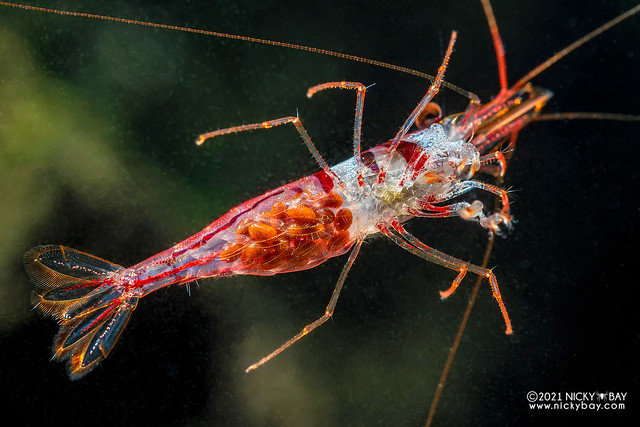



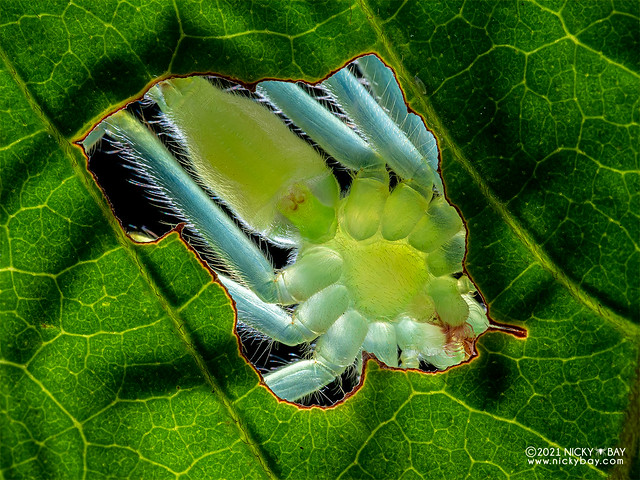
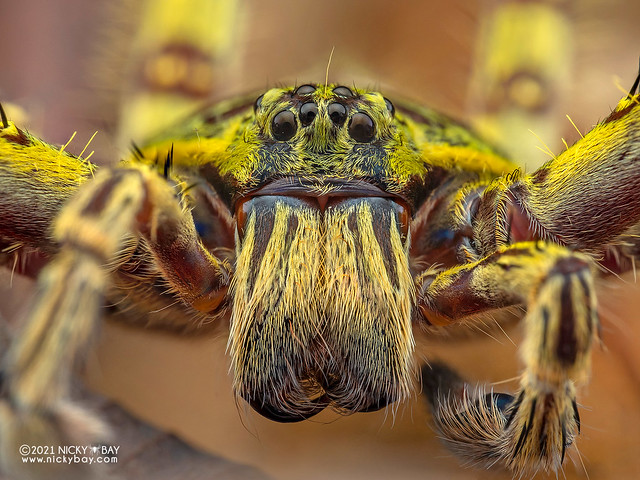

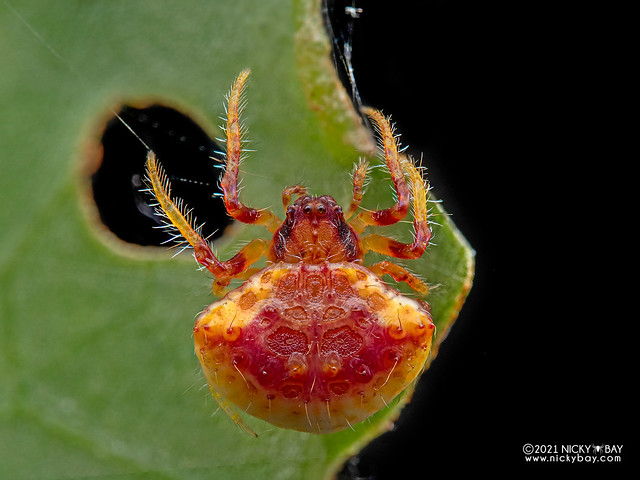
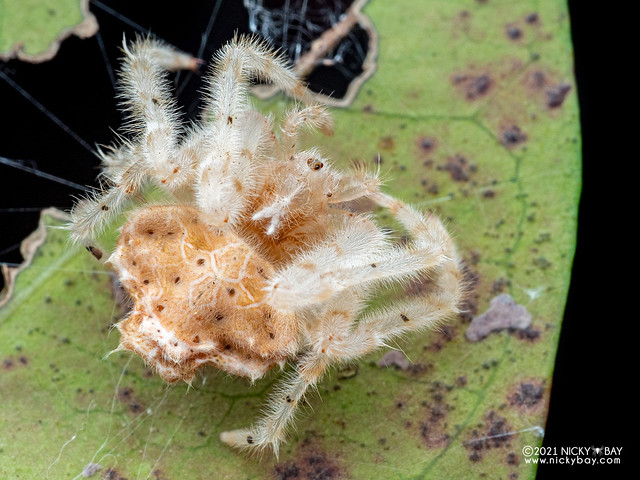
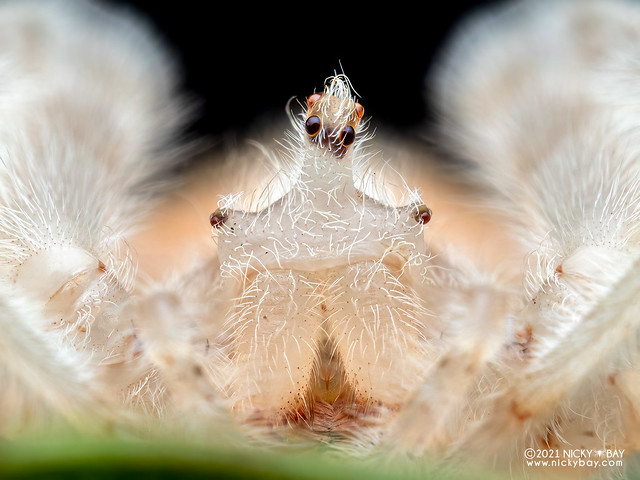


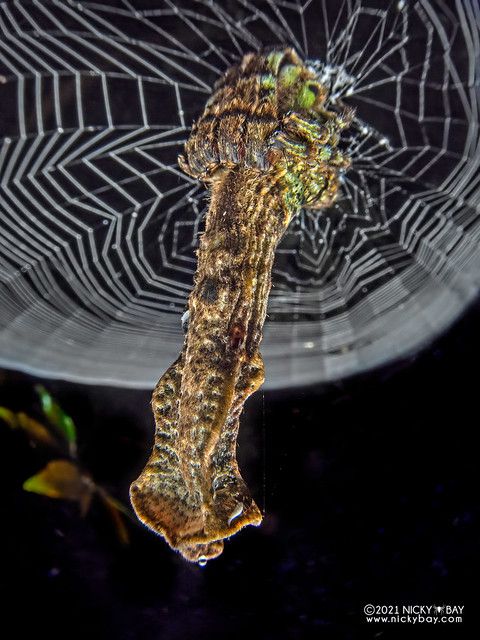




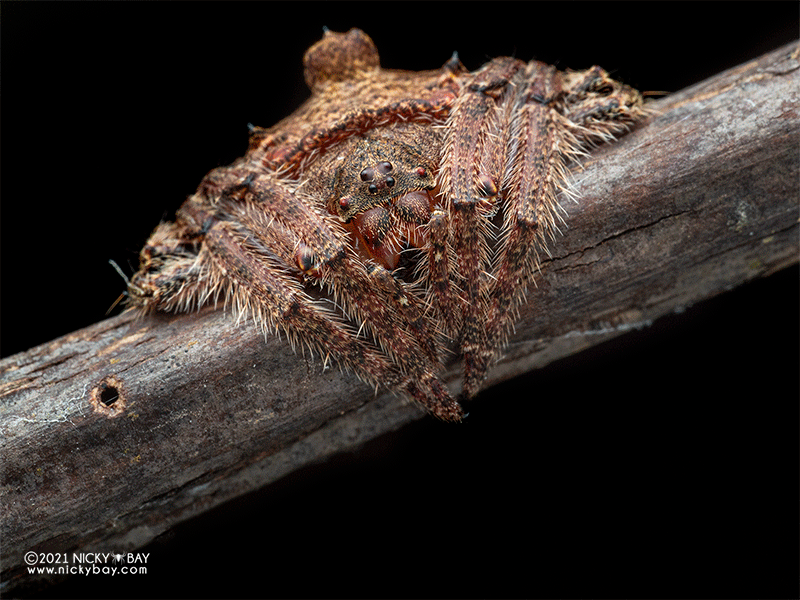




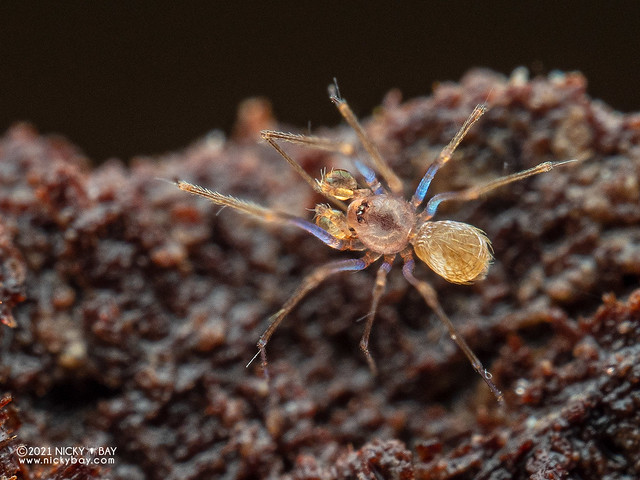

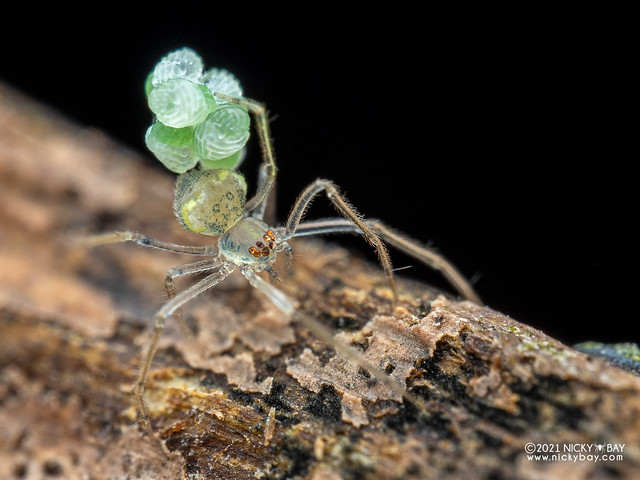


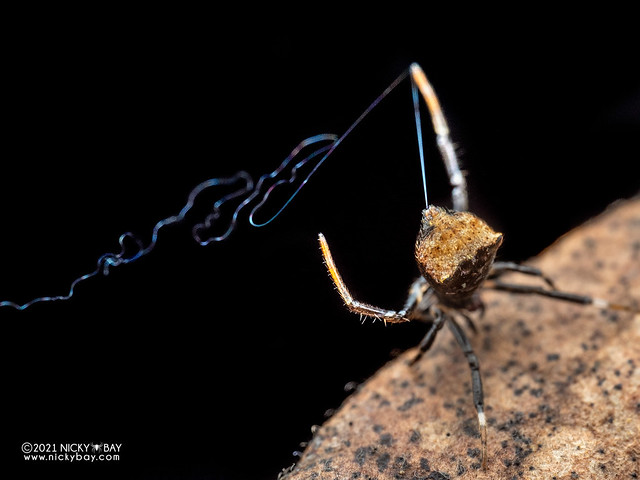



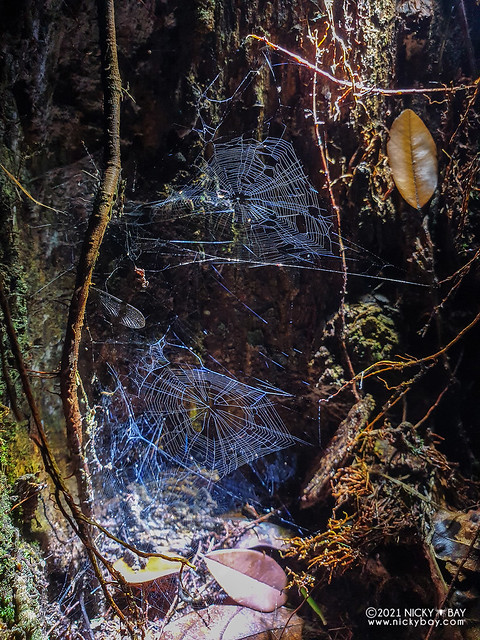
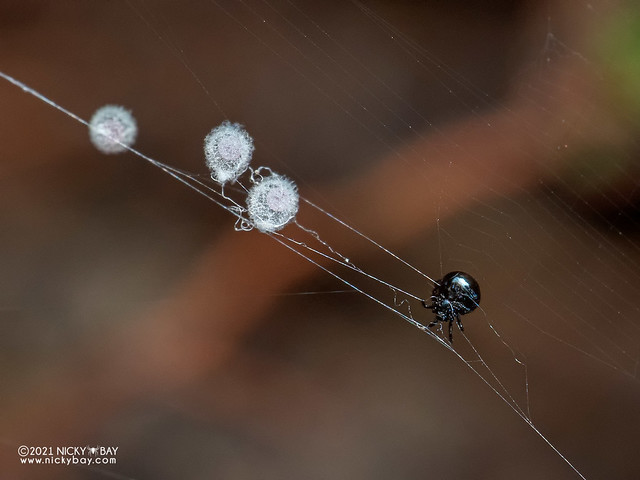



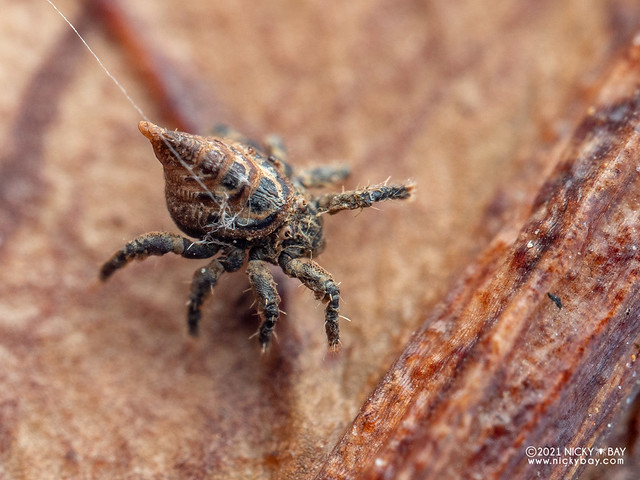




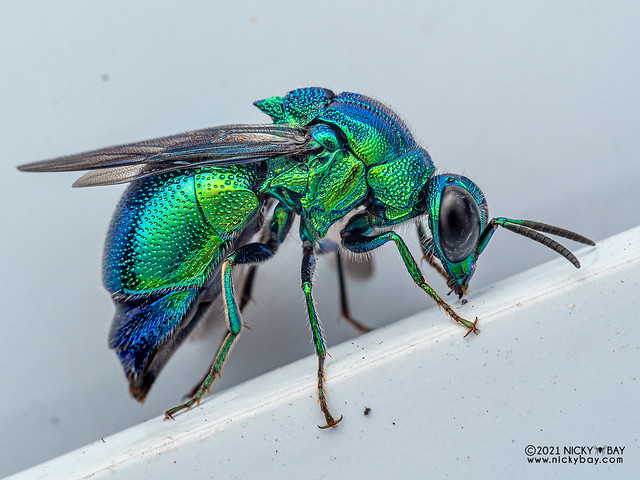
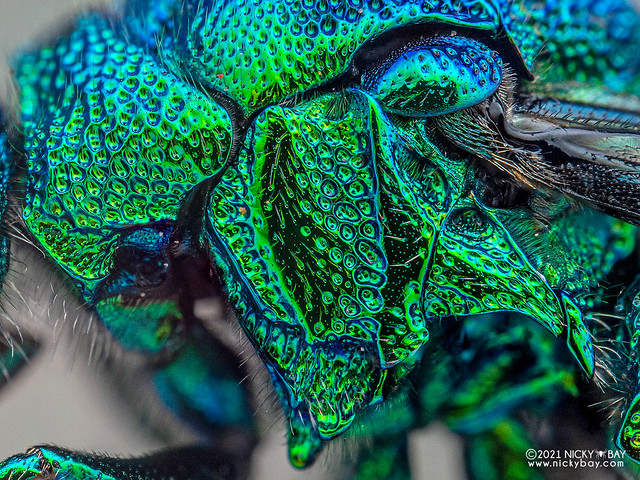



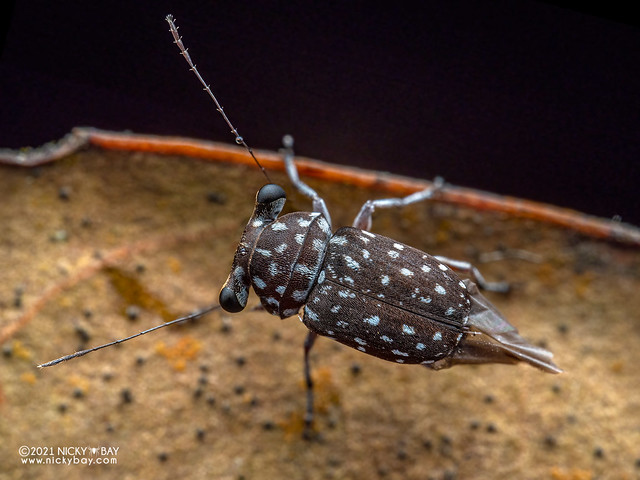

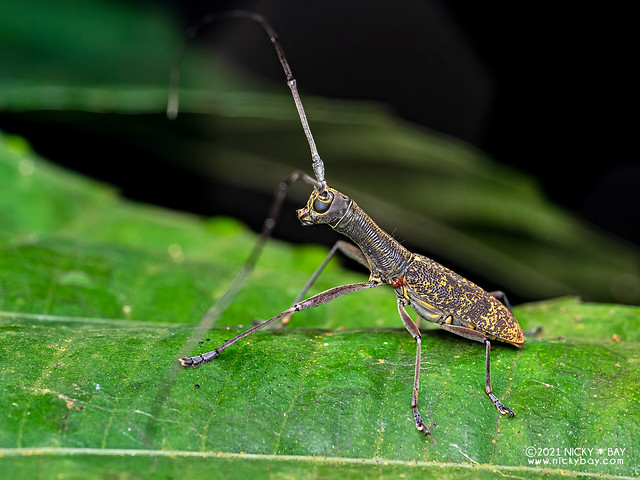







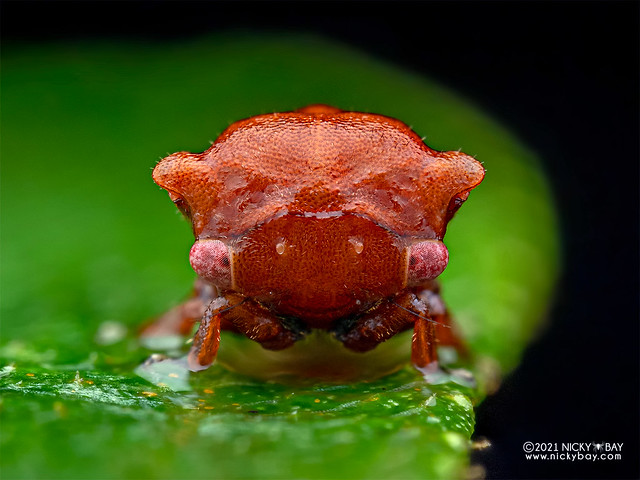
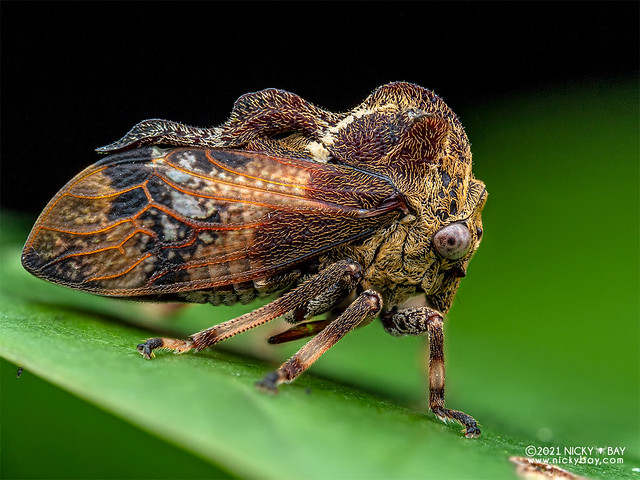




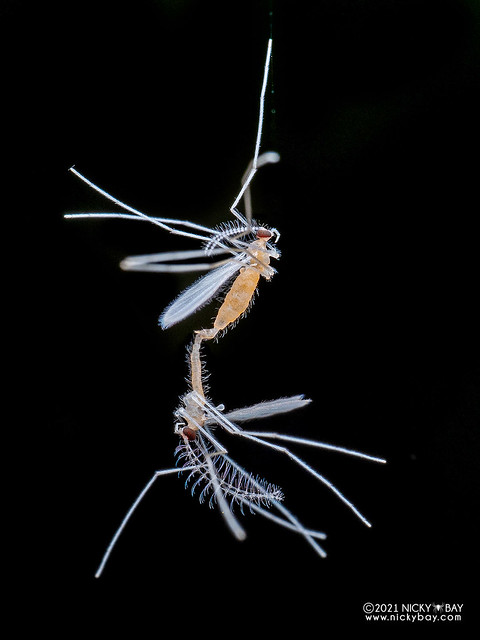
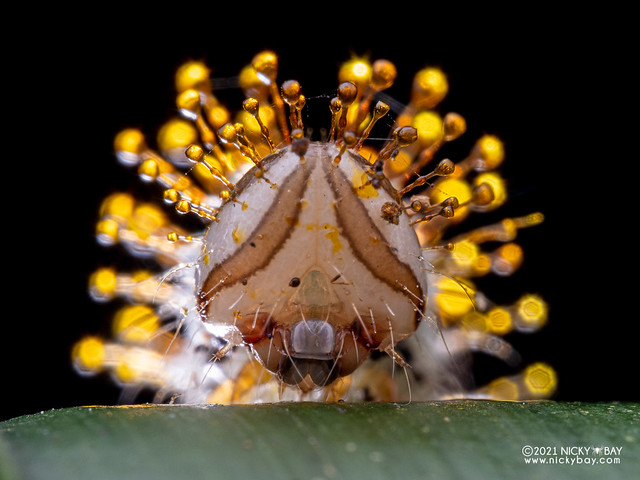



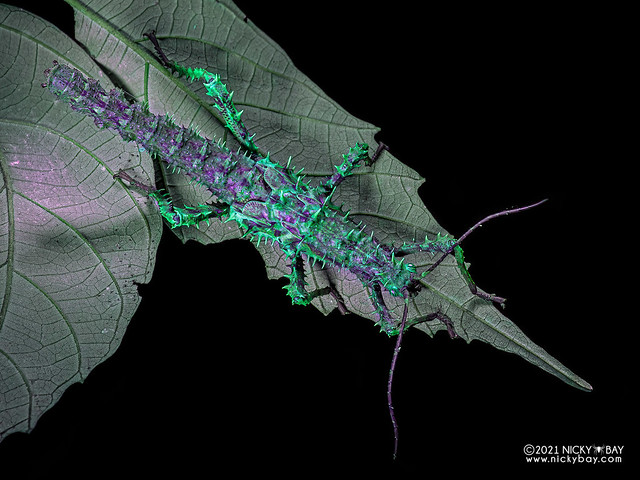
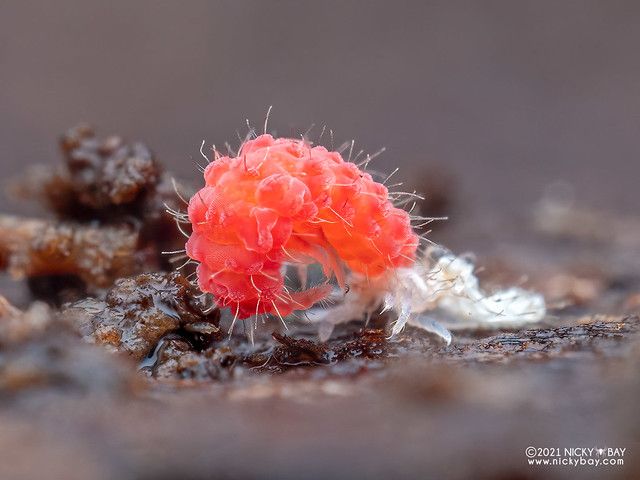

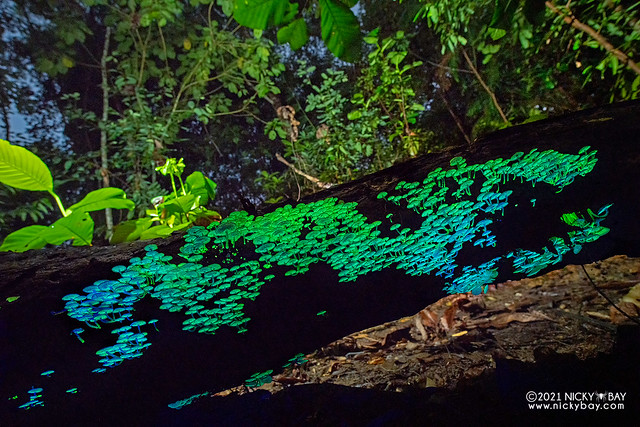




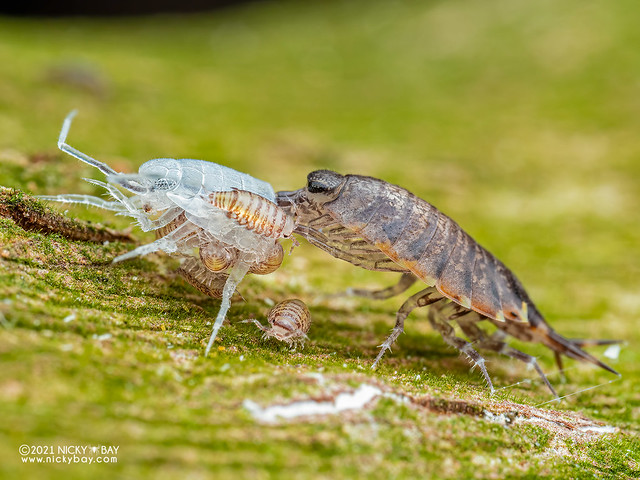

Bye Bye 2021!
While we can’t wait to travel again, exploring deeper into Singapore’s forests allowed me to discover numerous lifers this year. If all goes well, I should be able to resume some workshops in Borneo or the Amazon soon. Do subscribe to the mailing list (form on the right for desktops, or below for mobile) to keep yourself updated!

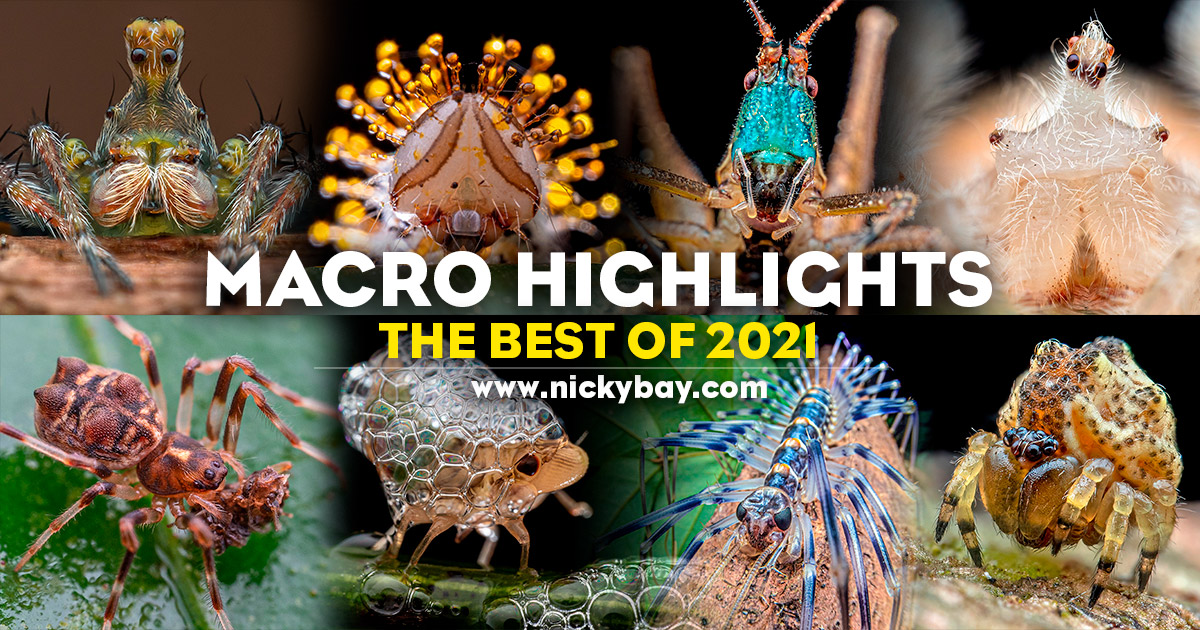


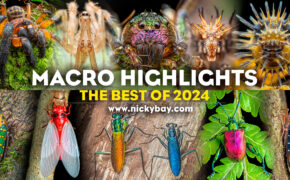
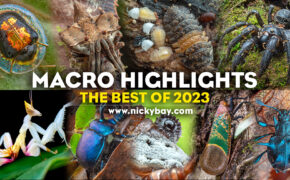













James L. Castner
Superb depth of field combined with engaging perspectives and framing! Beautifully done!
Warren Krupsaw
Your work is extraordinary: S.O.T.A. (State of the Art).
Aloke Sahu
This is a splendid collection, Nicky! Thank you for sharing your work; it is awe-inspiring!
Henry Robison
Nicky:
Loved your Best of 2021 photos! They are superb captures of most interesting organisms. Please keep up your fantastic work in 2022!
Vida Van Der Walt
As always, masterful work Nicky.
Joseph M Fabian
Wow! I’m amazed! This seems to be more of just stacking photos which would take a lot of shots with subject standing still! I’ve never seen anything like this and I’m always reading photography stuff!